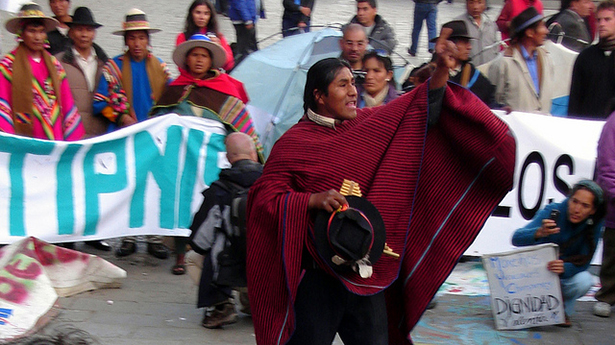By Dana Dallavale, Donor Relationship Manager
From the Amazon to the Andes, Bolivia’s rich forests and vast high-altitude deserts are home to the highest percentage of indigenous peoples in Latin America.
I recently spent a week traveling with our advisor in Bolivia, Ely Lopez. Ely is of Quechua descent, the most prominent indigenous group in Bolivia.
She has strong personal and professional connections to environmental and social justice movements in her home country, and she makes profound personal sacrifices to work as an environmental defender in a region where civil society is increasingly under fire by government and big industry.
Pristine wilderness under threat
 In recent years, the Bolivian government has ramped up its sponsorship of large-scale development projects. For example, expansive monoculture projects and copper, gold, silver, and lithium mines built deep in pristine wilderness arrive with miles and miles of road development. In protest, urban youth groups are joining together with rural communities to launch a movement against dirty mining and development, and to protect indigenous cultures.
In recent years, the Bolivian government has ramped up its sponsorship of large-scale development projects. For example, expansive monoculture projects and copper, gold, silver, and lithium mines built deep in pristine wilderness arrive with miles and miles of road development. In protest, urban youth groups are joining together with rural communities to launch a movement against dirty mining and development, and to protect indigenous cultures.
The situation in Isiboro Secure National Park and Indigenous Territory, known as TIPNIS, has drawn international attention and scrutiny. In 2011, Bolivian President Evo Morales approved the building of an 182-mile highway, part of which would run through this protected, highly biodiverse indigenous territory in the Amazon.
In 2011, Ely and her daughter joined a peaceful 375-mile march from deep in the Amazon to the capital city, La Paz, to protest the road, which if built would damage pristine rivers, open up massive sections of the park to logging, further threaten rare species, and greatly endanger indigenous communities.
Huge numbers of pregnant women, mothers, elderly people, and youth joined the dangerous trek. Women played an enormous role. The march broke no laws and blocked not a single road. Yet, the government blocked access to communication, police beat participants and tear gassed children, blocked the arrival of food and supplies from the city, and did all they could to quell the excitement and arrest leaders.
The march started to turn public opinion against the road, and Morales put a hold on the project. But the struggle goes on: In June, Morales announced that construction on the TIPNIS highway would resume.
Government-sanctioned violence
Morales’ international rhetoric on preserving the environment and indigenous peoples is hard to trust when Bolivia’s economy is so closely tied to natural resource extraction. To wit, movements protesting TIPNIS and social issues are increasingly in harm’s way.
Communities most affected by extractive industries’ environmental degradation have been paralyzed by a new mining law passed by Morales. The law legalizes mining cooperatives and allows them to use public water for their toxic operations. At the same time, it makes protests against mining operations illegal.
Ely spoke of an endangered nation in a time of reflection, with no current path forward for protecting the over 4 million indigenous peoples and some of the most diverse animal and plant life in the world.
What lies in the heart drives the struggle
 Superficially, Ely and the other members of our Andes Advisory Board from Peru, Ecuador, and Colombia (all women) find grassroots groups and local leaders who are poised to make significant progress to protect their people and environments. But if there’s one thing I took away from my time with Ely, it is that Global Greengrants’ advisors are even more than what is on their resumes.
Superficially, Ely and the other members of our Andes Advisory Board from Peru, Ecuador, and Colombia (all women) find grassroots groups and local leaders who are poised to make significant progress to protect their people and environments. But if there’s one thing I took away from my time with Ely, it is that Global Greengrants’ advisors are even more than what is on their resumes.
Their souls are deep in the struggle. The plight of their people to protect environments and cultures sits in the center of their hearts and is what drives them in every aspect of their life—not just professionally.
Every advisor I’ve met so far for Global Greengrants is deeply and personally connected to the struggles in their regions. Their passion, knowledge, and compassion are electric.
If anything can help change the state of Bolivia’s indigenous peoples and environmental degradation, it will be the work of those like Ely and the brave people who marched to the capital.
Photos from top: Pablo Andres Rivero, Szymon Kochanski / CC BY-NC-ND 2.0, Global Greengrants


